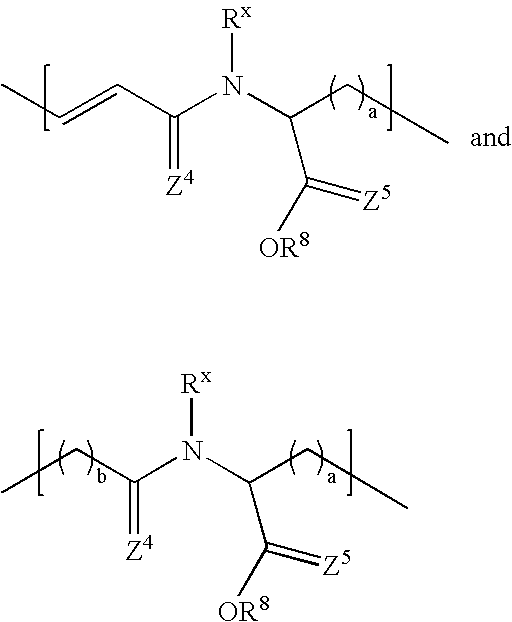N-substituted monomers and polymers
a technology of substituting monomers and polymers, applied in the field of n-substituted monomers and polymers, can solve problems such as interfering with the thermal processibility of polymers, and achieve the effects of significantly reducing the hydrogen bonding effect of monomers and polymers with peptide linkages
- Summary
- Abstract
- Description
- Claims
- Application Information
AI Technical Summary
Benefits of technology
Problems solved by technology
Method used
Image
Examples
example 1
N-alkyl Substitution
[0140]In a pressure vessel compound 8-EB is dissolved in DMF with K2CO3 (2 equiv) at room temperature and then treated with ethyl bromide (1.1 equiv.) dropwise via syringe. The pressure vessel is then sealed and the reaction is heated to 60° C., at 30 min intervals the reaction is allowed to cool to room temperature and the progress is checked by TLC (thin layer chromatography) or LC / MS. The reaction is quenched with water and the aqueous layer is extracted. The organic layer is dried over Na2SO4, filtered and the solvent removed under reduced pressure to afford 8-GB. The intermediate 8-GB is dissolved in DMF in the presence of excess K2CO3, then thiophenol is added and the mixture is stirred at room temperature until the completion of the reaction as indicated by TLC. The solid is removed by filtration and the solvent is removed under reduced pressure. The crude mixture is then dissolved in wet methanol / THF in the presence of catalytic NaOH, upon completion of t...
example 2
N-aryl Substitution
[0141]To a solution of phenyl iodide (1 mmol) and β-amino ester (9-C) (1 mmol) in DMF (5 mL) is added potassium carbonate (2.5 mmol), 0.1 mL of water, and CuI (0.1 mmol) under nitrogen. After the mixture is stirred at 10° C. for 48 h under nitrogen atmosphere, the cooled solution is concentrated in vacuo. The residue is dissolved in water, acidified to pH 5, and extracted with ethyl acetate. The combined organic layers are concentrated and purified by chromatography to afford the corresponding N-aryl β-amino acid (9-D).
[0142]The N-aryl β-amino acid (9-D) can be converted to the N-aryl β-amino acid by methods known to one of skill in the art. For example, the N-aryl β-amino acid can be treated with HCl in a solvent such as ethanol or methanol to afford the corresponding ethyl or methyl N-aryl β-amino esters.
example 3
N-Substituted Monomers
[0143]Monomer PP-IA:
can be synthesized from the monomer precursor of formula AA-1. In a typical embodiment, as shown in Scheme 10, the polymerization precursor 10-C can be synthesized from AA-1B. Iodination of 3-(4-hydroxyphenyl) propionic acid (10-A) affords 3-(4-hydroxy-3,5-diiodophenyl)propanoic acid. Subsequent coupling of 10-B with AA-1B followed by removal of the phenol protecting group afford the polymerization precursor 10-C. For example, treatment of 3-(4-hydroxyphenyl) propionic acid (10-A) with chloroiodide affords 3-(4-hydroxy-3,5-diiodophenyl)propanoic acid (10-B). Coupling of 10-B with AA-1B using N-(3-Dimethylaminopropyl)-N′-ethylcarbodiimide hydrochloride (EDCI) followed by deprotection of the phenol protecting group can afford the polymerization precursor 10-C. The removal of the methyl protecting group can be accomplished using boron tribromide (BBr3) in methylene chloride (DCM). The polymerization precursor 10-C can be converted into polymeri...
PUM
| Property | Measurement | Unit |
|---|---|---|
| melt viscosity | aaaaa | aaaaa |
| viscosity | aaaaa | aaaaa |
| structure | aaaaa | aaaaa |
Abstract
Description
Claims
Application Information
 Login to View More
Login to View More - R&D
- Intellectual Property
- Life Sciences
- Materials
- Tech Scout
- Unparalleled Data Quality
- Higher Quality Content
- 60% Fewer Hallucinations
Browse by: Latest US Patents, China's latest patents, Technical Efficacy Thesaurus, Application Domain, Technology Topic, Popular Technical Reports.
© 2025 PatSnap. All rights reserved.Legal|Privacy policy|Modern Slavery Act Transparency Statement|Sitemap|About US| Contact US: help@patsnap.com



